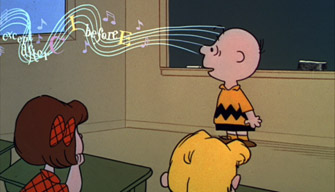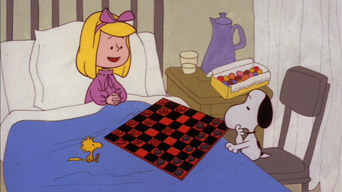

A Boy Named Charlie Brown and Snoopy Come Home DVD Review
by Scott McGuire / Peanuts Animation & Video Page / March 26, 2006
Two of the most requested Peanuts titles — the theatrical movies "A Boy Named Charlie Brown" and "Snoopy Come Home" — have finally been released on DVD by Paramount Home Video. Due out March 28, overall the DVDs look and sound good, and "A Boy Named Charlie Brown" is noteworthy because it features the little-seen longer edit of the film.


In 1969's "A Boy Named Charlie Brown," Charlie Brown enters the class spelling bee, determined to prove that he can win at something. Much to everyone's surprise, not only does he win there, but he wins the schoolwide competition, and so heads off to the national spelling bee championships in the big city... will he finally win big?
Snoopy receives a mysterious letter from a girl named Lila in 1972's "Snoopy Come Home." When he immediately packs up and leaves town, Linus and Charlie Brown discover the disturbing truth that Charlie Brown wasn't Snoopy's first owner... Lila was! And because she says she's sick and needs him, Snoopy may return to her permanently.
The movies successfully translate the qualities that made Peanuts a success both on television and the comics page to the big screen, and are fondly remembered as childhood fixtures by many adults for their moving storylines and catchy songs — surely you remember "I before E Except After C" and "Fundamental-Friend-Dependability." No doubt today's children will find them just as entertaining.

Both DVDs feature remastered widescreen transfers of the movies, enhanced for widescreen 16:9 TVs (known as "anamorphic widescreen"). It looks like Paramount went back to the vault to make fresh transfers of the movies for DVD; in both cases, the pictures are bright, sharp without excessive edge enhancement, and very colorful. For example, the somewhat psychedelic images that accompany Schroeder's performance of Beethoven's Moonlight Sonata in "A Boy Named Charlie Brown" are eye-popping. The movies look far better than they did on the previous VHS releases.
Unfortunately, "A Boy Named Charlie Brown" needed more cleanup than it apparently received. While it has good color and contrast, there's lots of dust and sparkle, some scratches, and a couple of scenes with print damage. Ultimately I found the flaws slightly distracting and disappointing, given the transfer's other good qualities.
On the other hand, "Snoopy Come Home" looks excellent for the most part. There's just the odd dust speck or smudge here and there. The video quality is much superior to the full-frame DVD of the movie that was released in the UK, Australia, and Japan last year.
This is the first time the movies have been released in widescreen on home video. Whether this was the correct choice or not is a matter of debate; since the VHS releases presented the full frame of the original films, the DVDs actually show less of the picture than the VHS releases, and the movies look a little cramped as result of the choice. This is not necessarily wrong, but there are some concerns. See below for a detailed discussion of this issue.
"A Boy Named Charlie Brown" features a new English 5.1 Surround soundtrack, which is pleasant but not aggressive. There are just a few directional sounds, such as off-screen voices and an occasional sound effect. Mostly the surround speakers are used to spread out the movie's popular and Academy-award nominated musical soundtrack, which works well, giving the songs additional presence. The DVD also includes an English 2.0 Stereo track. "Snoopy Come Home" comes with just an English 2.0 Stereo track, but it sounds clear and and has a reasonable range given the age of the film. There are no soundtracks for other languages, and there are also no subtitles at all, not even for English (although both DVDs do have closed captioning). There are no extras on either DVD.
However, the best news is that the "A Boy Named Charlie Brown" DVD uses the longer, 86-minute edit of the film. Two different edits of the movie exist: the shorter 79 minute version used for all previous home video versions, and a longer 86 minute version that originally aired in the theaters. This means there are about 7 minutes of footage that haven't been seen in three decades! The two "missing scenes" that appear only in the longer version have been restored: Lucy's "therapy" for Charlie Brown — a slow-motion replay of his failure to kick the football — and Charlie Brown's conversation with hotel room service near the end of the movie. There are also many slightly extended versions of scenes that were already in the shorter version. The longer, unedited version of the film has been much sought after by fans for a long time, so kudos to Paramount for releasing it on DVD.
"Snoopy Come Home" is also complete and unedited; both films even include the original Cinema Center Films logo at the beginning.
I definitely recommend both DVDs. "Snoopy Come Home" looks very nice, and the positives of the longer version of "A Boy Named Charlie Brown" outweigh the less than pristine print, especially compared to the dull (and edited) VHS release. The DVDs are both affordably priced, with a list price of $14.98, so you should be able to find them in the $10-12 range, especially on-line.

Many fans have started asking "will the other two Peanuts movies be released on DVD soon?" So far Paramount hasn't made an announcement regarding them, but there is another Peanuts DVD to look forward to — Paramount has announced a two DVD set containing all eight episodes of "This is America, Charlie Brown," due out on June 13th.
About the Aspect Ratios of the Peanuts Films
According to folks at Bill Melendez Productions, the Peanuts theatrical movies were originally created in the same almost square 1.33:1 (aka 4:3) aspect ratio used for the television specials, and then matted down (the top and bottom removed) to create a widescreen picture for movie theaters.
The previous VHS and Laserdisc releases of the two movies used the entire original 1.33:1 frame — they were not pan and scan versions of the widescreen films. As a result, they actually show more of the picture than you would have seen if you saw the films in a movie theater. But this means that in order to create widescreen versions for the DVDs, part of the picture had to been removed again, so compared to the VHS releases, the DVDs show less of the picture.
Widescreen movies come in a range of aspect ratios, from 1.66:1, just slightly wider than a square, all the way to 2.35:1, a very wide ratio used for the most epic of films. So the question is, how much of the picture should have been removed to create widescreen versions of the Peanuts movies? Unfortunately, my research indicates that no one remembers what the original aspect ratio used for the movies in the theaters actually was.
Paramount chose to the movies on DVD in an 1.78:1 aspect ratio, which is the most common widescreen aspect ratio, and the one that will completely fill a new 16:9 widescreen TV. While I commend Paramount for attempting to release "A Boy Named Charlie Brown" and "Snoopy Come Home" as viewers originally saw them in theaters, I think this choice leaves the two movies looking a little cramped on the top and the bottom; it looks like the slightly taller 1.66:1 aspect ratio would have been a better choice. But it's impossible to say for sure if the choice of the 1.78:1 aspect ratio is wrong, and it isn't awful; it's just that over the years we've gotten used to the full frame versions of the movies!
Note that the end credits of "A Boy Named Charlie Brown" and both the opening and end credits of "Snoopy Come Home" on the DVDs are "windowboxed" (black bars on the left and right), leaving the credits in something very close to their fullframe aspect ratio — they are slightly cropped down to about a 1.4:1 ratio (they are not 1.66:1 as some reviews have stated). If Paramount had cropped the credits to 1.78:1 like the rest of the movie, some of the names would have been practially touching the top or bottom edges of the pictures, and likely not visible on some televisions.